By Martin J. Greenberg and Jacob Peters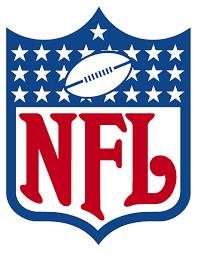
I. Introduction
Since its introduction in 2003, the Rooney Rule has served as the basis for integration of diversity in the National Football League (NFL). At its core, the Rooney Rule requires NFL teams to interview minority candidates for both head coaching and general manager vacancies before the individual teams name their hires.[1] Many activists, as well as former NFL players and coaches felt that the NFL was not doing enough to promote diversity in their workplace, particularly within these two positions in NFL organizations. Individuals including Hall of Famer Kellen Winslow, John Wooten, along with civil rights lawyers Johnny Cochran and Cyrus Mehri led the campaign for change in the NFL in 2002.[2]
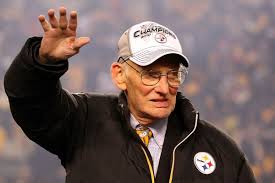 Dan Rooney, former owner of the Pittsburgh Steelers, acted as the spearhead among NFL owners, and lead the charge to put the Rule in place in 2003. This effort followed the firing of two African-American coaches in 2002, Tony Dungy of the Tampa Bay Buccaneers, and Dennis Green of the Minnesota Vikings.[3] Dungy was fired after producing a winning record with the Buccaneers.[4] Civil rights lawyers were able to produce evidence and data following the 2002 season which showed African American coaches won a higher percentage of games, and still were less likely to be hired, and more likely to be fired.[5] [6]
Dan Rooney, former owner of the Pittsburgh Steelers, acted as the spearhead among NFL owners, and lead the charge to put the Rule in place in 2003. This effort followed the firing of two African-American coaches in 2002, Tony Dungy of the Tampa Bay Buccaneers, and Dennis Green of the Minnesota Vikings.[3] Dungy was fired after producing a winning record with the Buccaneers.[4] Civil rights lawyers were able to produce evidence and data following the 2002 season which showed African American coaches won a higher percentage of games, and still were less likely to be hired, and more likely to be fired.[5] [6]
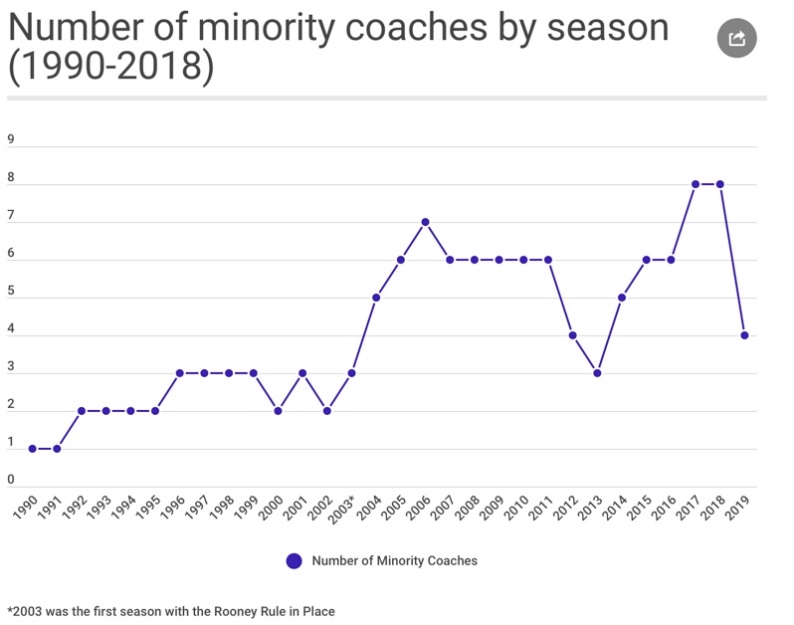 Initially, the NFL saw an increase of minority candidates being hired by teams to fill vacant head coaching and general manager positions, but since the early stages of the Rooney Rule, organizations and owners have been rumored to attempt to circumvent the Rooney Rule and have no true intention of hiring a minority candidate.[7] There have been 108 head coaching hires since 2003.[8] Of those 108 hires, only 21 minority candidates have eventually stepped in and took the reins of an NFL team.[9] These 21 minority candidates have winning percentages spanning from 65.6% (Anthony Lynn of the Los Angeles Chargers) to 0.88% (Hue Jackson with both the Oakland Raiders and Cleveland Browns).[10] According to the Undefeated, 38.1% of minority coaches in the NFL lead their teams to winning records, while only 32.2% of white coaches are able to lead their teams to a winning season.[11] At the same time, there is a larger percentage of minority coaches also leading their teams to losing records.[12]
Initially, the NFL saw an increase of minority candidates being hired by teams to fill vacant head coaching and general manager positions, but since the early stages of the Rooney Rule, organizations and owners have been rumored to attempt to circumvent the Rooney Rule and have no true intention of hiring a minority candidate.[7] There have been 108 head coaching hires since 2003.[8] Of those 108 hires, only 21 minority candidates have eventually stepped in and took the reins of an NFL team.[9] These 21 minority candidates have winning percentages spanning from 65.6% (Anthony Lynn of the Los Angeles Chargers) to 0.88% (Hue Jackson with both the Oakland Raiders and Cleveland Browns).[10] According to the Undefeated, 38.1% of minority coaches in the NFL lead their teams to winning records, while only 32.2% of white coaches are able to lead their teams to a winning season.[11] At the same time, there is a larger percentage of minority coaches also leading their teams to losing records.[12]
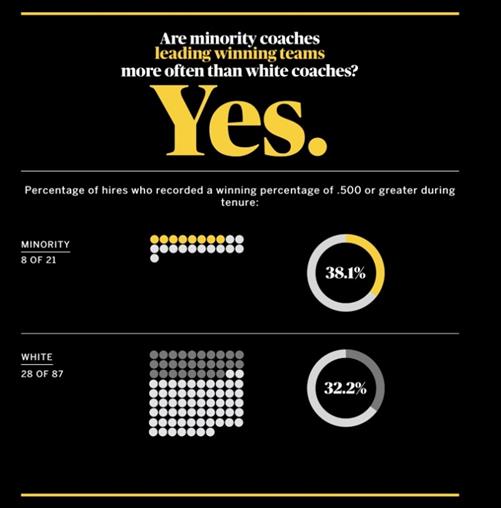 A determining factor in the NFL coach’s success with their team is the position the team finds themselves in when the new head coach arrives. 14.3% of the minority coaches hired by NFL teams find themselves in situations where their teams are only projected to win five games maximum in their first full year at the position.[13] White coaches only find themselves in the same position 8% of the time, and this may be a large factor which impacts the success of the Rooney Rule and the NFL’s main goal of diversity amongst NFL coaches and general managers.[14]
A determining factor in the NFL coach’s success with their team is the position the team finds themselves in when the new head coach arrives. 14.3% of the minority coaches hired by NFL teams find themselves in situations where their teams are only projected to win five games maximum in their first full year at the position.[13] White coaches only find themselves in the same position 8% of the time, and this may be a large factor which impacts the success of the Rooney Rule and the NFL’s main goal of diversity amongst NFL coaches and general managers.[14]
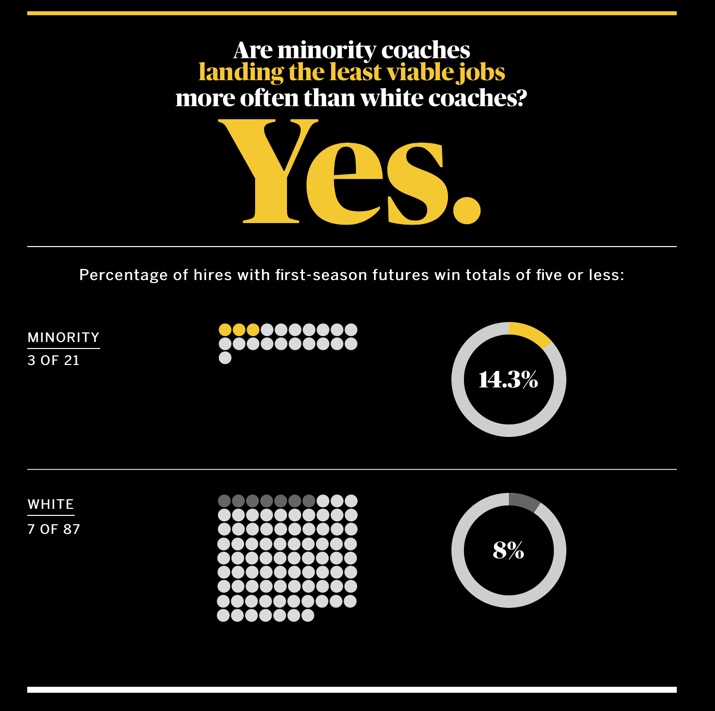
II. Post 2018 NFL Regular Black Monday Season:
During the 2018-19 NFL regular season, there were many teams that were considered to have underperformed. Of the thirty-two NFL franchises, six coaches were fired after the season concluded, along with two coaches being fired mid-season.[15] The Cincinnati Bengals fired Marvin Lewis after sixteen seasons at the helm.[16] The Cleveland Browns fired Hue Jackson after two and a half seasons as the head coach of the team.[17] The Denver Broncos relieved Vance Joseph of his duties as head coach after two seasons.[18] The New York Jets fired Todd Bowles after four seasons leading his team.[19] Also, the Arizona Cardinals fired Steve Wilks surprisingly after only one year as head coach of his team.[20] Other coaches to be fired during the season included Adam Gase after three years as head coach of the Miami Dolphins, Mike McCarthy after thirteen seasons at the helm of the Green Bay Packers, and Dirk Koetter after serving as head coach of the Tampa Bay Buccaneers for three seasons.[21]
Of the eight head coach firings, five of them were minority coaches.[22] Many of the minority coaches were fired after only a few years of service at their positions, and many pundits and individuals in the football universe tend to believe that these coaches were not given their fair opportunity to showcase their abilities at the helm of their football teams.[23]
III. Study of Each Teams Progress under Fired Head Coaches
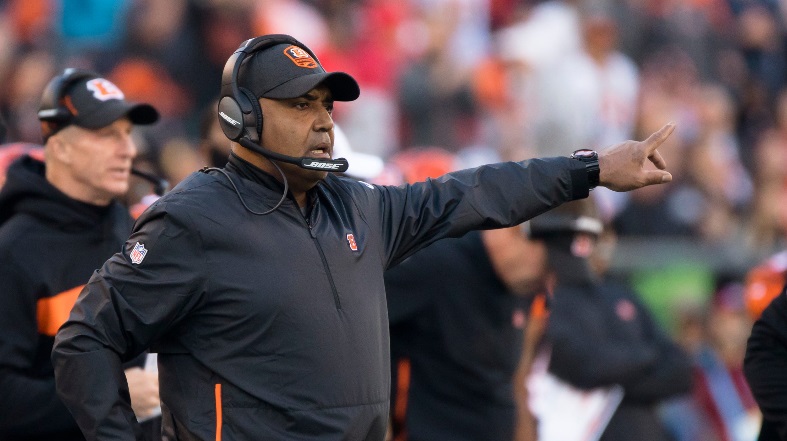

- Marvin Lewis, Cincinnati Bengals
Before his firing, Marvin Lewis (Lewis) was the second longest tenured coach in the NFL, only behind head coach for the New England Patriots Bill Bilichick, serving as head coach of the Cincinnati Bengals (Bengals) for sixteen seasons.[24] His overall record as head coach of the team was 131-122-3.[25] This translates to only a .518 win percentage during his tenure, which ranks him thirty-fifth out of the 108 hires during the Rooney Rule era.[26] But, Lewis had a very strange career when it comes to his time in Cincinnati. When he was hired in 2002, the Bengals had faced fourteen years without recording a winning season.[27] In his first four seasons, he was able to produce a winning record, and was also able to win his division, the AFC North in 2005.[28] Because of the early success, the owner of the Bengals, Mike Brown (Brown), bequeathed a significant amount of power to Lewis, and entrusted him with the success of his franchise.[29]
Lewis brought a sense of professionalism to the Bengals, which had been missing under their former head coaches during their fourteen year losing drought, and was able to convince Brown to supply basics, including water and Gatorade during practice, which the Bengals roster was not accustomed to receiving.[30] But his sense of comfortability was seen as his kryptonite, according to many Bengals fans and writers.[31]
Brown was able to draft his quarterback of the future in the 2011 NFL Draft Second Round following Carson Palmer, franchise quarterback, had a significant and gruesome knee injury. Andy Dalton was able to take the reins and was a successful replacement, and this afforded Lewis more time at his position with the organization.[32] With Dalton, the Bengals from 2011-2015 went a combined 52- 27 and attained playoff berths in each year.[33] But, the Bengals were never able to capitalize for their regular season success in the playoffs, and fizzled out each year after only playing one playoff game each year.[34] Lewis’ record in the playoffs with the Bengals was 0-7 during his time in Cincinnati, and fans began to become upset with the end result of each team year to year.[35]
After the 2015 season, Lewis saw a significant drop off in the success of his team, and the best record he was able to record in the three years following his last playoff berth was 7-9 in 2017.[36] Lewis suffered three straight losing seasons, something he had not done during in tenure in Cincinnati, and there was roster options and assistant coach hires which exhibited a different style of coaching that Lewis had not utilized in the past.[37] 2018 was assumed to be a do or die year for the long time Bengals coach, and after injuries to key players, including their number one wide receiver A.J. Green and quarterback Andy Dalton, owner Brown finally cut ties with Lewis.[38]
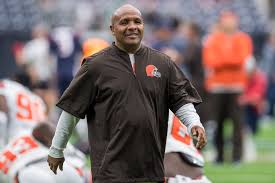
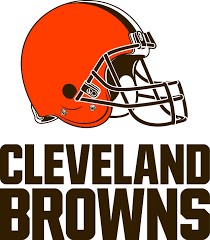
- Hue Jackson, Cleveland Browns
Hue Jackson (Jackson) was hired by Jimmy Haslam, owner of the Cleveland Browns (Browns), in 2016 to take over one of the most dysfunctional organizations in professional sports.[39] Jackson was relieved of his duties during the middle of the 2018 season after posting a record of 3-36-1.[40] Jackson’s record landed him a .088 win percentage during his time as head coach, and this ranks 107th out of the 108 minority coaches that have served as head coach in the League.[41] Though his record speaks to the success of the club, Jackson was not able to get the Browns to the playoffs during his three years.[42]
Jackson clearly had a tough time during his tenure as Browns head coach. In his three years there was significant turnover year to year in terms of both the roster and assistant coaches, and there were minimal expectations.[43] In his first two seasons, Jackson went 1-15 in 2016 and 0-16 in 2017.[44] This was only the second time in NFL history that a franchise went winless, and there was a clear lack of urgency and ability that the team posed in those two years.[45] A true indicator of Jackson’s tenure was his final half season, before he got fired midseason after a 2-5-1 start to the 2018 season.[46]
After having back to back years with the first overall pick in 2017 and 2018 as well as the fourth pick in the 2018 NFL Draft, the roster saw significant improvement and there was a buzz in both the locker room and the City of Cleveland that this would be the year the team would turn it around.[47] After coming off a Heisman trophy season at Oklahoma, Jackson and the Browns drafted Baker Mayfield with the first overall pick in last year’s draft, but he was not named the original starter.[48] In the majority of his games though, the Browns were significantly more competitive than in the previous two years but were still one or two significant plays away from winning the majority of their games under Jackson.[49] But silly and untimely penalties that plagued the franchise for years along with turnovers, missed field goals, and special teams plays lead to losses in overtime as well as ties. [50] Mayfield was able to win two games under Jackson, but a blowout loss to the division rival Pittsburgh Steelers ended Jackson’s tenure in Cleveland.[51]
The Browns finished the year 7-9-1 under interim coach Gregg Williams.[52] The team was much more competitive and fully functioning after the firing of Jackson.[53] When Jackson was fired, he was rehired by his former boss Lewis in Cincinnati to help the defense and he continued to struggle there.[54]

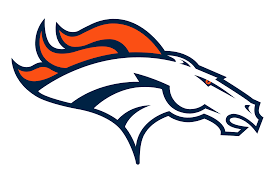
- Vance Joseph, Denver Broncos
Vance Joseph (Joseph) was hired by John Elway and the Denver Broncos (Broncos) in 2016 and coached for two years.[55] The Broncos won the Super Bowl in 2016 and their Head Coach resigned after winning because of health issues.[56] The Broncos in this time lost their quarterback Peyton Manning and have been searching for his replacement ever since.[57]
Joseph was considered a defensive specialist and with the way the Broncos roster was situated, it looked like a perfect fit.[58] The franchise decided to take a defensive first approach with the likes of Von Miller and Aqib Talib as the cornerstones of their defense.[59] But, this led to significant issues on the offensive side of the ball both years of his tenure. Joseph’s record resulted in a .344 win percentage, which ranked eightieth out of 108 hires during the Rooney Rule era.[60] This also was the worst winning percentage of any Broncos head coach who coached for more than a full season.[61] Under his watch, the Broncos had their first back-to-back losing seasons since 1971, and their first back-to-back 10-loss season since 1967.[62]
Joseph consistently saw his team perform at low levels and not live up to its potential in big games.[63] One of the issues the team faced also in his second year was the high profile signing of quarterback Case Keenum to be the successor after a great year in Minnesota, where he led the Vikings to the NFC Championship.[64] Keenum struggled to perform and was very inconsistent, only throwing for 3,890 yards and 18 touchdowns, while also throwing 15 interceptions.[65] Keenum also was sent packing by the Broncos and is slated to be the starting quarterback for the Redskins prior to training camp.[66]
Joseph clearly struggled in Denver as a head coach and was not able to recreate the magic the defense was able to in their 2016 Super Bowl run.[67]
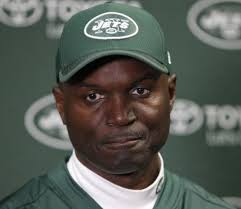
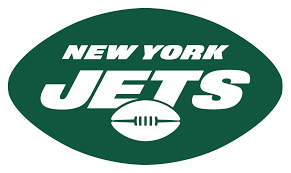
- Todd Bowles, New York Jets
Todd Bowles (Bowles) was hired by the New York Jets (Jets) in 2015 and was relieved of his duties after four seasons.[68] Bowles posted an overall record of 24-40 and was not able to secure a playoff berth for his franchise.[69] This record translates to a .388 win percentage, which ranks as sixty-fifth out of the 108 NFL head coaching hires during the Rooney Rule era.[70]
Before being hired by the Jets, Bowles was one of the most sought after head coaching candidates in the NFL, after being a successful defensive coordinator in Arizona.[71] Bowles was the recipient of the first AP Assistant Coach of the Year Award in 2014, before being hired by the Jets.[72] In his first year in 2015, Bowles led a successful campaign, going 10-6, but was still not able to make the playoffs due to a strong year in the AFC that season.[73] Bowles pledged he would lead his team to the playoffs the next year, but this ended up becoming an empty promise.[74]
The next two years, the Jets saw their win percentage drastically drop, going 5-11 in both of those seasons.[75] Finally, Bowles led the Jets to a 4-11 2018 season after being on the hot seat after the previous two years.[76] The Jets this past season entered the year planning on developing their quarterback of the future, Sam Darnold.[77] Darnold struggled to start the year, throwing 14 interceptions before November 2018, but was able to come back after an injury held him out three weeks to only throw one interception the rest of the year.[78]
Bowles’ tenure as Jets coach essentially came to an end after a 41-10 thrashing by division rival Buffalo Bills, but Jets franchise tradition allows for the coach to complete the season.[79] Players in the locker room commended Bowles’ professionalism in the locker room during the time it was known he was going to be relieved of his services following the year.[80] This still was not an excuse according to Bowles, who stated “The record says it all” when it came to his firing.[81] Bowles was the sixth-straight defensive focused coach hired to take the reins of the Jets.[82]


- Steve Wilks, Arizona Cardinals
The last minority coach to be fired, and the most controversial firing, was Steve Wilks (Wilks) with the Arizona Cardinals (Cardinals).[83] Wilks was the head coach of the Cardinals for only one season, and posted a record of 3-13, and was not able to make the playoffs in a competitive NFC West.[84] This translated to a .188 win percentage, which ranks 100th out of 108 NFL head coaching hiring’s during the Rooney Rule era.[85]
Wilks is one of the only coaches in NFL history to be hired at the beginning of an NFL season and not get a second year to show his ability as head coach.[86] In comparisons to other coaches, it is tough to show the progress or lack thereof of his team due to a small sample size.[87] But there are still many strange occurrences in Arizona that make this an interesting case.
The Cardinals started the season 0-4, and showed a real lack of ability to compete with any teams in their division or the rest of the League.[88] Their offense and defense were both among the worst in the NFL, and the team had been outscored 59-6 through the first two games of the season.[89] The Cardinals had both signed Sam Bradford to a lucrative one year deal, expecting him to be the bridge to quarterback of the future and top ten pick Josh Rosen, but Bradford was severely inconsistent and was replaced in the fourth quarter of their week three loss by Rosen.[90] Four weeks later, Wilks fired his offensive coordinator after a blowout loss to the Denver Broncos on national television.[91]
Team President Michael Bidwell decided to give Wilks a full season to showcase his ability as head coach, but there was so much turmoil within their team that it did not help his cause.[92] Bidwell mentioned after the season, “[w]hen I look back at last year, obviously I didn’t get it right. I take responsibility for it, and we’re going to make sure we get it right this time around.”[93] There was a significant quarrel between the front office and Wilks about the defensive philosophy that Wilks was trying to instill in the players.[94] The team transitioned from a 3-4 defense to a 4-3, and front office executives did not think that this switch was tailored to the players in the locker room and that the defense was suffering for it, as the team finished last in the NFL in rushing yards per game.[95]
Many of the leaders on the team claimed that other players were not adjusting and fixing their mistakes week to week, particularly on the defensive side of the ball.[96] There was also a significant amount of injuries to the roster, as demonstrated by their offensive line’s health.[97] His entire starting offensive line was eventually sidelined for the year by Week fourteen.[98]
Wilks also experienced turmoil during training camp when his General Manager Steve Keim was suspended for five weeks after a DUI charge.[99] This part of the season is when the coach and the general manager decide on key roster moves and decisions that will shape the team’s look for the entirety of the season.[100] Wilks was tasked with selecting his roster by himself, and eventually was punished by the general manager following his suspension when him along with the president of the team fired Wilks at the conclusion of the season.[101]
IV. Head Coach Hires for 2019 Season/Justification for Change?
Although the firings following the 2018 NFL season may be considered by many as unwarranted, the aforementioned franchises still needed to fill the void that the former head coaches left upon their departure from their position. Following the eight firings of NFL coaches, and five of them being minority, only one minority candidate received an offer to become a head coach in the League.[102] Brian Flores, former assistant coach for the New England Patriots, was hired to replace Adam Gase in Miami for the Dolphins.[103] Every other coach hired during the 2018-19 NFL coaching scenario was a white candidate, whether they were considered qualified for the position or not.[104]
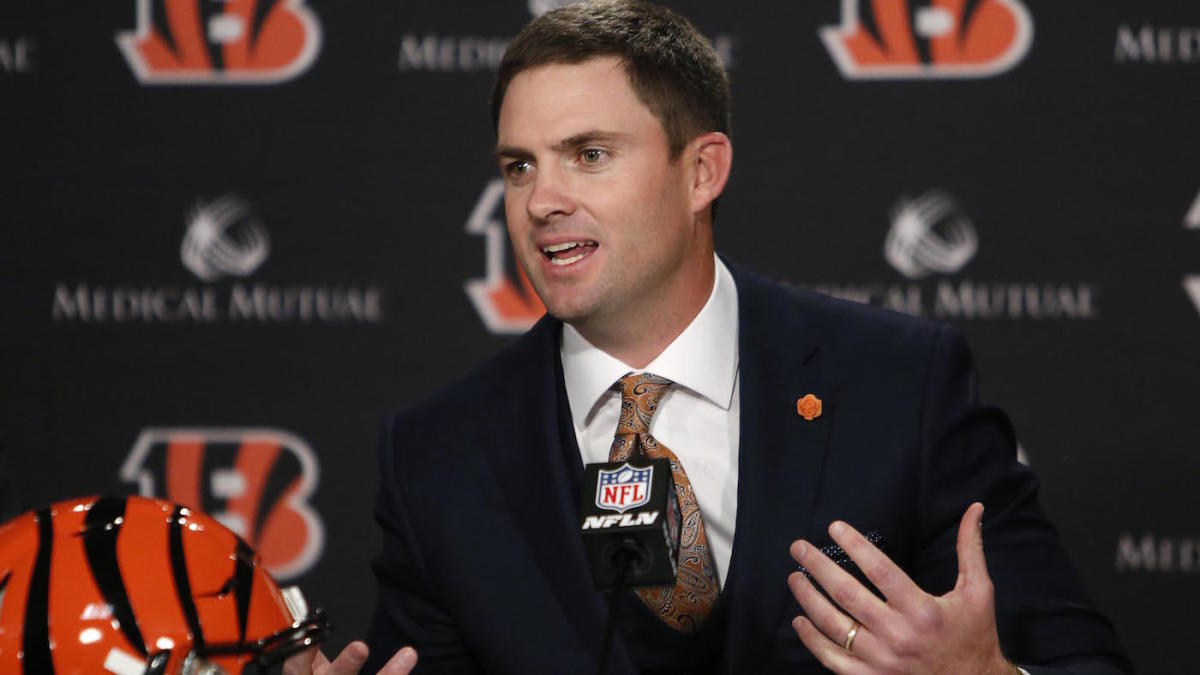
- Zac Taylor, Cincinnati Bengals
Zac Taylor (Taylor) served the 2018 season as the quarterbacks coach for the Los Angeles Rams.[105] Taylor was considered a lock for the job when he was interviewed in January of 2019, but the team had to wait out the postseason successes and the run that the Rams had to the Super Bowl.[106] Taylor oversaw the growth of one of the game’s young quarterback’s, Jared Goff, and during his Goff’s third year, Taylor helped groom the quarterback.[107] Goff threw for 4,688 yards and 32 touchdowns in 2018, an increase from 3,804 yards and 28 touchdowns the year before.[108] Goff was a pro bowl quarterback in 2018, and the Bengals believed that Taylor will be able to unleash Andy Dalton in the same way he was able to with Goff.[109]
NFL teams in recent years have recognized the importance of the quarterback head coach relationship. Whether it be the likes of Tom Brady and Bill Bilichick, or a younger relationship like Doug Peterson and Carson Wentz, strong relationships like these produce Super Bowl winning teams and franchises.[110] Many teams have begun to reach on candidates, based on short term success as coordinators or even as a college coach.[111] Taylor, only thirty-five years old, has not had the opportunity to be a head coach until the Bengals offered their job to him, and only has had five games experience as an offensive coordinator.[112] In this time as the Dolphins interim offensive coordinator, the team averaged 17 points, less than what they were averaging previous to his promotion.[113] In the same vein, the Bengals last year has the worst defense in the League, and Taylor will not only have to create a renaissance for Andy Dalton, but also fix their defensive issues if they want to be competitive in an already tough division, the AFC North.[114]
Taylor has had experience in the Cincinnati area, as an offensive coordinator for the University of Cincinnati, but the team’s offense in his one year also was significantly worse than the year before Taylor took over.[115]
Looking at the hiring of Taylor by the Bengals, it is hard to say if this decision was warranted.[116] Lewis was one of the most tenured coaches in the League and has a history of turning around poor teams from the year before and coaching his team to a playoff run.[117] The deciding factor in whether firing Lewis was a wise decision will be the play of Dalton as it has regressed in the past few years, and if the quarterback whisperer who is not as qualified as other candidates can turn his play around.[118]
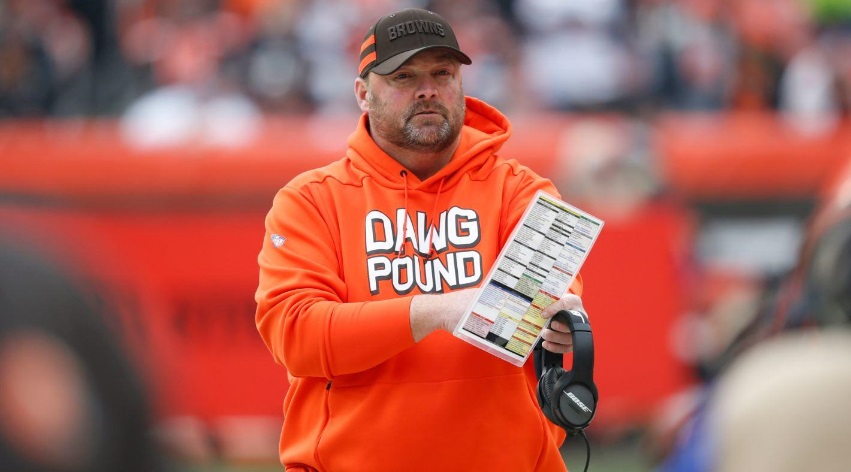
- Freddie Kitchens, Cleveland Browns
Freddie Kitchens (Kitchens) began the 2018 season as the running backs coach of the Browns, and after Jackson was fired midseason, he was promoted to offensive coordinator, and he was very successful in that role.[119] The Browns ranked twenty-ninth in the NFL in opponent-adjusted passing metrics before Kitchens took over.[120] Following the promotion, Kitchens as play caller and leader of the offense elevated the passing game of the Browns to second in the League.[121] The reasoning the Browns gave for the hiring of Kitchens was his relationship with the Browns quarterback Baker Mayfield.[122] Mayfield saw his completion percentage jump ten percent with Kitchens, and his quarterback rating jump almost 30 points in the same time.[123]
But, Kitchens is also a coach who is inexperienced and even one which many did not even expect to get a coaching opportunity.[124] Kitchens was not on any team’s interview list in the winter of 2018, but because of the success he had with his opportunity in Cleveland, and the successful relationship he made with quarterback Baker Mayfield, the Browns believed him to be the perfect successor to Jackson.[125]
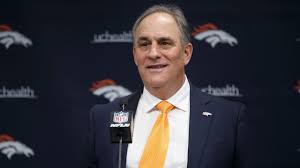
- Vic Fangio, Denver Broncos
Vic Fangio (Fangio) is one of the most experienced coaches in the NFL, having served thirty-two years as an NFL assistant.[126] Most recently, Fangio was the defensive coordinator of the Chicago Bears for the past four seasons.[127] In 2014, the Bears had one of the worst defenses in the League, and Fangio was able to turn that group into the number one scoring defense, and the Bears led the NFL in takeaways in 2018.[128]
Fangio is one of the few head coach hires to not be an offensive coach.[129] John Elway, general manager for the Broncos, wanted experience, and he indeed got one of the most experienced assistants the League has to offer.[130] Fangio has won Assistant Coach of the Year, and is inheriting one of the strongest defenses in the NFL, with the likes of Von Miller and Nick Chubb leading the way in Denver.[131] For Fangio, his role will be to make sure the defense meets expectation, and leave the offense to his offensive coordinator Gary Kubiak.[132] Fangio has a tough road ahead for him though, as this job brings high expectations, and playoff implications.[133]
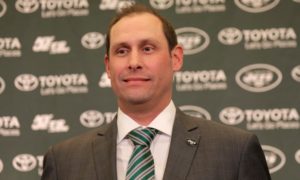
- Adam Gase, New York Jets
As mentioned previously, Adam Gase (Gase) served as the head coach of the division rival Miami Dolphins before getting hired by the Jets.[134] Gase will be able to get a second chance at coaching, and he will get that chance with the likes of his young quarterback Sam Darnold (Darnold), who looks like the future franchise quarterback.[135]
Gase struggled in Miami due to the health of his quarterback, but many people, including Peyton Manning, think Gase is the right hire to develop Darnold.[136] Gase’s success will be judged on the growth of his quarterback, and his failure in Miami to be more than mediocre will be forgotten.[137]
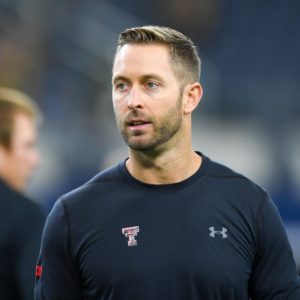
- Kliff Kingsbury, Arizona Cardinals
Kliff Kingsbury (Kingsbury) takes over as the Cardinals head coach, after they hired Steve Wilks one year earlier.[138] Kingsbury has only coached at the collegiate level, having served as the Texas Tech head coach for six years.[139] During those six years, Kingsbury posted a 35-50 record overall, and only 19-35 in Big 12 play.[140] This also only includes two winning seasons, those of which came earlier in his tenure.[141]
Kingsbury is considered a coach who establishes strong relationship with his players. Following a year for the Cardinals that saw a struggling locker room, it will be essential for him to win over the minds of proven veterans like Patrick Peterson and Chandler Jones, while at the same time developing a strong relationship with whomever the quarterback of the Cardinals is next year.[142]
As previously mentioned, many of the NFL teams are attempting to re-create the success that colleges are having currently with their offensive production, particularly the passing game.[143] Kingsbury has coached a top 25 scoring team in Division I football.[144] Kingsbury is going to have the opportunity to groom a quarterback, presumably Kyler Murray, to make the air raid offense successful in the NFL.[145]
Kingsbury is considered a reach for an NFL head coaching gig, but a reach the Cardinals were willing to take based on the struggles under Wilks.[146] Wilks was not given a fair opportunity, and was only employed for one year.[147] Kingsbury struggled to win at the collegiate level, and many believe that will translate in the NFL.[148] The Cardinals however are willing to take that risk, due to the lack of offensive production since Bruce Arians retired.[149]
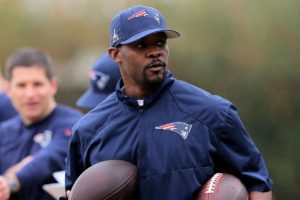
- Brian Flores, Miami Dolphins
Brian Flores (Flores) has spent the past eleven seasons with the New England Patriots, learning under who is arguably the greatest head coach in the history of the NFL, Bill Bilichick.[150] Out of the eight head coaching hires around the League, Flores was the only candidate hired who is a minority coach.[151] Flores has won three Super Bowls as an assistant coach, and last year was the play caller for the defense that won the Super Bowl and only gave up three points to one of the best offenses in the NFL.[152] The Patriots defense last year gave up the seventh-fewest points in the League, and managed to get better week to week.[153]
Flores takes over a team that is looking to get the first overall pick in the next NFL draft, which means his expectations are very low going into the 2019 NFL season.[154] Flores is the only minority head coaching candidate to be hired in the NFL coaching carousel, and he is only one of two defensive minded coaches to be hired this cycle.[155] It will be interesting to see how the next Bilichick disciple does without the help of the great coach, but Flores should have the Dolphins behind him, and he will get an opportunity over multiple years to show his competency as a head coach.[156]
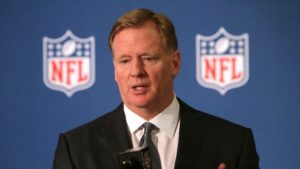
V. Additional Changes to the Rooney Rule after the 2017-2018 Season
The NFL envisions the Rooney Rule as one that has transformed the country’s viewpoint on diversity in the workplace and one that has shaped policy nationwide when it comes to hiring. While many teams have embraced the Rooney Rule and abided by it, there are many organizations in the NFL that have “side-stepped” the process and have left questions about the validity and the enforceability of the Rooney Rule.
One situation that led to the recent changes in the Rooney Rule was the hiring of Jon Gruden (Gruden) by the Oakland Raiders (Raiders) after the 2017-18 season.[157] According to Mark Davis (Davis, principal owner and managing general partner of the Raiders, there was an agreement in place with Gruden on December 24, 2017, accepted over a dinner and before any minority candidates were interviewed for the position.[158] The Raiders officially hired Gruden on January 6, 2018.[159] The Raiders were also known not to have interviewed any minority candidates and did not comply with the Rooney Rule as of three days prior to the announcement of the hiring of Gruden.[160] News of the Gruden agreement spread like wildfire throughout the League, and was even made public before their head coach, Jack Del Rio, was fired after the conclusion of the season.[161] The Fritz Pollard Alliance, an organization that advocates for diversity in the NFL, believed that Davis violated the Rooney Rule due to his hiring of Gruden.[162] The Fritz Pollard Alliance also conceded that the minority candidate, Tee Martin (Martin), was earnestly interviewed, but Martin had never been considered for a head coaching position in the NFL, and was solely interviewed for a second place finish.[163]
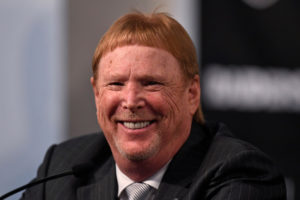

The Gruden splash hiring was long in the making.[164] In order to comply with the Rooney Rule, the Raiders could have had an informal chat with a minority member of their current coaching staff.[165] They could have interviewed someone who was out of the League.[166] They could have even brought in a rising minority coach from another team just for the sake of appearances.[167] Of course, this would all be for show, but would have been in compliance with the Rooney Rule – at least the minimum standards.[168]
This is not the first time that potentially a sham interview has occurred:
Back in 2010, there were major questions raised about whether the Washington Redskins and Seattle Seahawks skirted the rule before hiring Mike Shanahan and Pete Carroll, respectively, as their head coaches. Before the Redskins officially hired Shanahan, owner Daniel Snyder supposedly interviewed the team’s secondary coach, Jerry Gray, who is African-American. The Seahawks were far down the road with Carroll before they interviewed African-American Leslie Frazier, at the time the Minnesota Vikings’ defensive coordinator. Carroll was hired shortly after Frazier, now Buffalo’s defensive coordinator, interviewed.[169]
With Shanahan and Carroll both being high-profile candidates who seemed to have the jobs locked up, it appeared that Gray and Frazier were only being used to help the teams adhere to the rule. Nevertheless, the Fritz Pollard Alliance checked off on everything.[170]
Changes were made after the Gruden hiring at a Special NFL League Meeting in December of 2018.[171] Those changes included the following:
- Clubs must interview at least one diverse candidate from the Career Development Advisory Panel list or a diverse candidate not currently employed by the club;
- Clubs must continue best practice recommendation of considering multiple diverse candidates;
- Clubs must maintain complete records and furnish to the [L]eague upon Commissioner’s request; and
- If final decision-maker is involved in the beginning, he/she must be involved through the conclusion of the process.[172]
Roger Goodell, Commissioner of the NFL, stated as to the changes to strengthen the Rooney Rule:
Since the inception of the Rooney Rule, we have seen the Rule adopted across business sectors and considered an industry best practice to increase diversity. . . The policy updates made today will bolster the current Rooney Rule requirements and are intended to create additional opportunities for diverse candidates to be identified, interviewed, and ultimately hired when a vacancy becomes available.[173]
The action taken by the NFL in the December 2018 meetings was for the purposes of reducing the possibility of sham interviews and making certain that at least one qualified minority candidate is interviewed for either the head coaching or general manager vacancies.[174] Repeating once again –
[r]evisions include mandating that teams interview candidates from outside their organizations, including those deemed viable by the [L]eague’s career development advisory panel, maintaining complete records pertaining to the process that must be turned over to the [L]eague upon request and a requirement that final decision-makers participate in the interviews for every candidate.[175]

Even after the Rooney Rule changes, five minority coaches were fired, which only leaves three minority coaches left leading teams into the 2019-20 season.[176] The three minority coaches left at their positions are Mike Tomlin of the Pittsburgh Steelers, Ron Rivera of the Carolina Panthers, and Anthony Lynn of the Los Angeles Chargers.[177] After the off-season’s firings, there was cause for concern that minority coaches’ futures are in question due to a lack of enforceability of the Rooney Rule.[178]


A clear concern of advocates for diversity in the NFL is that minority coaches are not getting as fair of an opportunity to showcase their abilities in a fair timeframe in comparison to other white coaches in the League.[179] Fritz Pollard Alliance counsel Cyrus Mehri said, “We see what happened this time as primarily the regular, rough-and-tumble part of the NFL business — win or go home. But we remain very optimistic about where things are going forward.”[180] “We all know its win or go home said John Wooten, chairman of the Fritz Pollard Alliance.”[181] The records for the minority coaches released were reported as follows: “Marvin Lewis (Bengals, 6-19), Vance Joseph (Broncos, 6-10), Todd Bowles (Jets, 4-12), Hue Jackson (Browns, 7-8) and Steve Wilks (Cardinals, 3-13).”[182]
As mentioned previously, many of the franchises in the League have been able to bypass the main point of the Rooney Rule, to interview quality candidates for their positions. Many teams have set up allegedly sham interviews in the past to comply with the Rooney Rule because these franchises have already identified their next head coach.[183] With the introduction of the changes to the Rooney Rule, the hope is teams will interview in-house candidates who have the credentials to warrant serious consideration.[184] If they do not decide to go this route, the teams now will have to interview candidates that are listed on the NFL’s Career Development Advisory Panel list as well as a list of black assistant coaches who should be considered to move up each hiring cycle that is compiled by the Fritz Pollard Alliance, which helps oversee compliance of the Rooney Rule.[185]
The changes to the Rooney Rule also require the top decision maker, in most cases the owner of the franchise, to be involved in the hiring process through the entire time the team is searching for a coach.[186] Therefore, this change requires the owner to be present for all interviews, not just the ones he thinks are the best fit, and require attendance for minority candidates.[187]
The changes to the Rooney Rule have also brought attention to a huge issue that has been present since its inception in 2002, discipline in the form of sanctions or penalties for violation. Robert Gulliver, League executive in charge of Human Resources, stated there will be discipline handed out to franchises who do not comply with the Rooney Rule.[188]
There are many forms of discipline the League office could impose against teams who violate the Rooney Rule. In 2003, the NFL fined the Detroit Lions for not interviewing a minority candidate, and that fined reached $200,000.[189] If the League is serious about implementing the Rooney Rule and having teams fully comply with it, the League might take draft picks from teams that clearly violate the Rooney Rule. Teams covet draft picks, as they take up roster spots for a minimal hit to the team’s salary cap. If the League decided to take away draft picks, similarly to teams that are found to have violated other rules, then there might be more of a reason for teams to comply with the Rooney Rule, which would more likely than not lead to better minority candidates getting interviews or getting hired.
 Many pundits have weighed in with regards to the actions that occurred this year on Black Monday. John Wooten, chairman of the Fritz Pollard Alliance stated,
Many pundits have weighed in with regards to the actions that occurred this year on Black Monday. John Wooten, chairman of the Fritz Pollard Alliance stated,
[y]ou dislike anyone to be fired because of what it does to families. It really knocks you back, and so forth, but you also understand that there are certain realities about this game, and the No. 1 reality is coaches have to win. We just have to make sure we’re showcasing people of color and giving them opportunities, which we do through the Rooney Rule.[190]
 Sports broadcaster, Dale Hansen, argued the latest series of head coaches’ appointments in the League suggested black coaches remained likely to be overlooked.[191] Hansen looked specifically at the firing that took place in Arizona with Wilks.[192] He commented on Kingsbury and said, “Kingsbury fits all the criteria to be a head coach in the NFL: He’s an offensive genius, he’s young – and he’s white, and not necessarily in that order.”[193] He continued, “There have been six new coaches hired so far, all white and two coaches of color. They are replacing Steve Wilks, fired in Arizona after just one year, and Vance Joseph in Denver after just two.”[194] Finally, on ESPN, Louis Riddick, who has a history in the NFL as a team executive also lashed out and said the firings of the five black coaches were “significant” for the League.[195] If the Rooney Rule isn’t implemented correctly, many minority coaches may be overlooked in the future, and could traumatically hurt the NFL and the progress the League has made since 2002.
Sports broadcaster, Dale Hansen, argued the latest series of head coaches’ appointments in the League suggested black coaches remained likely to be overlooked.[191] Hansen looked specifically at the firing that took place in Arizona with Wilks.[192] He commented on Kingsbury and said, “Kingsbury fits all the criteria to be a head coach in the NFL: He’s an offensive genius, he’s young – and he’s white, and not necessarily in that order.”[193] He continued, “There have been six new coaches hired so far, all white and two coaches of color. They are replacing Steve Wilks, fired in Arizona after just one year, and Vance Joseph in Denver after just two.”[194] Finally, on ESPN, Louis Riddick, who has a history in the NFL as a team executive also lashed out and said the firings of the five black coaches were “significant” for the League.[195] If the Rooney Rule isn’t implemented correctly, many minority coaches may be overlooked in the future, and could traumatically hurt the NFL and the progress the League has made since 2002.
VI. The Impact of the NFL’s transition to an Offensive League on the Rooney Rule
The NFL has been known for being one of the most successful leagues, and this is mainly for its ability to adapt and produce a product that people want to watch every week. Ever since the creation of the forward pass, this has become one of the most electric plays in all of football. Today, offense is the main focus of many franchises. Besides a handful of coaches, the majority of the coaches in the NFL have offensive backgrounds, and this has been the focus of the most recent hirings following Black Monday 2018.[196]
One of the main issues the NFL currently has is the number of minority head coaching candidates that work on the offensive side of the ball.[197] According to the data, “white hires are twice as likely to be offensive coordinators (35.6% compared to 19%), while minority hires are almost twice as likely to be defensive coordinators (47.6% compared with 24.1%).”[198] Below, you can find a chart that breaks down head coach hires by position they had previously served by percentages.

There are a few minority offensive candidates to look to in the future to garner consideration for head coaching positions. Eric Bieniemy, Offensive Coordinator for the Kansas City Chiefs, has been on many teams’ radar after the success he had with quarterback Patrick Mahomes and their offense.[199] Duce Staley, Assistant Head Coach and Running Backs Coach in Philadelphia Eagles, is also a viable minority candidate to watch going forward.[200] He is known to be able to work well with the players and get them to buy into systems that may be foreign to them, or initially doesn’t interest the player.[201]
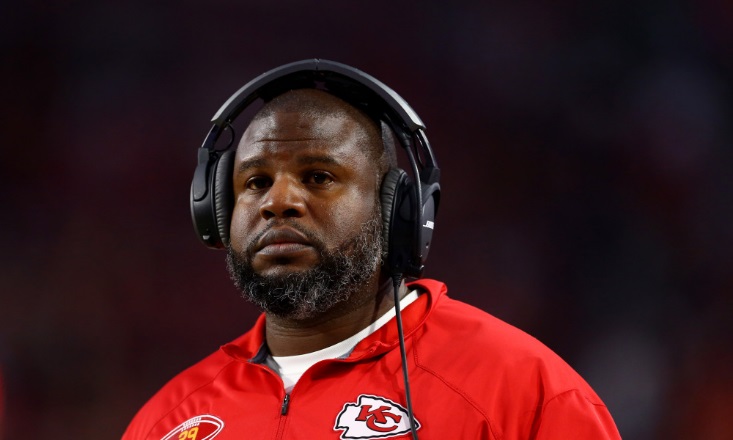
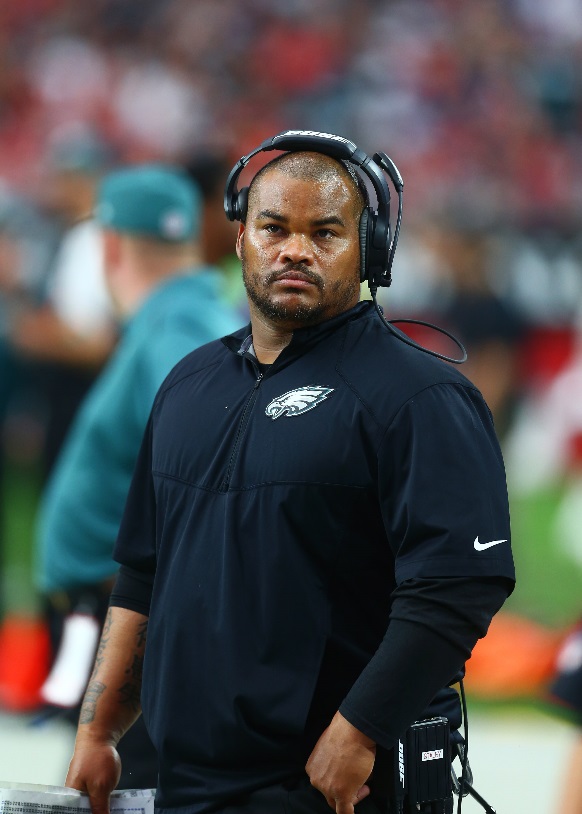
It appears that more African American coaches would be hired as head coach if they were on the offensive side of the game. A General Manager indicated that the one issue in the NFL today was the availability of African American Offensive Line Coaches – the NFL needs to work on this.[202] In another instance, League personnel had difficulty and struggled to name an African American coach who is an up and coming hotshot on the offensive side of the ball.[203] One source, who is African American and is currently interviewing the teams, has “said that in many cases the Rooney Rule has become an exercise in box-checking.”[204]
In June of 2011, an Indiana University economist, Todd Walker, along with Benjamin Solow and John Solow, published an article in Labour Economics entitled “Moving on up: The Rooney Rule and minority hiring in the NFL” wherein the researchers questioned the impact of the Rooney Rule on NFL hiring practices.[205]
The study also found little evidence of racial discrimination in the hiring of head coaches in the NFL, either before or since the Rooney Rule was adopted. The authors suggest that, if the [L]eague wants to increase the number of minority head coaches, it should focus on getting more African-Americans and Hispanics in the pipeline through low-level coaching positions.[206]
The findings “pointed out that minority coaches are much more under-represented in the college ranks than in the pros — and this may create a challenge for achieving equity, because many coaches break into the NFL as position coaches after starting out with college teams.”[207]
“You need to expand the pool of available talent, and the way to do that is to get more minority coaches involved early on,” Walker said.
Often, he said, former players enter the coaching profession by serving as volunteer assistants while attending graduate school, a route that may be less open to minorities. If the NFL wants to expand the future talent base of coaches, he said, it might consider providing financial and other support for African-Americans and Hispanics who want to learn coaching after college.[208]
VII. The Future of the NFL’s Rooney Rule
It goes without saying that the Rooney Rule was a revolutionary piece of legislation not just for the NFL, but for the country as a whole. The NFL holds themselves in high regard when it comes to the development of diversity in the workplace. Many different corporations and organizations have strived to meet the NFL’s success in producing high level minority candidates, and only few have seen significant growth. But, with recent developments by owners of NFL franchises, this growth has recently been stalemated, and has actually seen a decline in minority head coaches in the NFL.[209] As mentioned by Jeremi Duru, author of Advancing the Ball Race, Reformation and the Quest for Equal Coaching Opportunity in the NFL:
This is the lowest number of black coaches in the [L]eague since 2002 when Herm Edwards stood alone after Tony Dungy and Dennis Green were fired…. The Rooney Rule has been good for the [L]eague, and over the years we’ve seen clubs consider and hire candidates they might not have otherwise, but we’ve also seen clubs pay the rule lip service considering the candidate of color…. There must be more. We need other good ideas about how to create opportunity for head-coach aspirants of color.[210]
As of late, NFL franchises have taken the latter approach and have found ways to deliver lip service to both the NFL offices and the minority candidates they are so-called interviewing for their vacant head coaching positions.[211] The NFL and its partners continue to publicly state that it is happy with the way the Rooney Rule has affected the minority coaching candidate’s success of hire.[212] As Fritz Pollard Alliance has stated, “[w]hile the NFL ‘probably won’t have eight minority head coaches again in ’19, there should be at least four or five, and hopefully seven or eight again by ’20.”[213] The League and the organizations affiliated with the NFL continue to stand by the Rooney Rule currently as implemented, but there are ideas and ways to improve the Rooney Rule, and ensure that minority coaches are getting as fair as a shot as other candidates are for head coaching positions in the NFL.
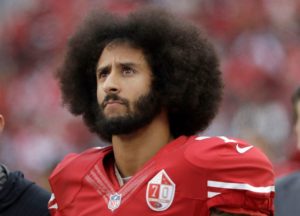 Clearly, much of the NFL’s discussions center not only around football and game plans, but also race. Colin Kaepernick, former San Francisco 49ers quarterback, made sure of it when he began to kneel for the national anthem before every one of his games during the 2016 season.[214] He was protesting racism and police brutality towards people of color, and this has caused him to not be able to secure a job with an NFL team because of the concern NFL owners potentially have with his views and how those views will be perceived by their fan base.[215] There are many pundits that believe that this type of timid behavior has translated to the selection of head coaches by owners and general managers alike across the League.[216] The NFL and other affiliated persons will never admit that the current Rooney Rule does not effectively put minority coaching candidates in positions to succeed and find a way to break onto the scene as an NFL head coach, but this is truly the case.[217] Teams have been doing only the bare minimum to comply with, or sidestep, the Rooney Rule for many years.[218] The majority of the NFL head coaching positions today come from offensive coaching positions, whether they be a quarterbacks coach, an offensive coordinator, or just a play-caller for a successful offensive team.[219] In most cases, minority candidates do not fall into such a category.[220]
Clearly, much of the NFL’s discussions center not only around football and game plans, but also race. Colin Kaepernick, former San Francisco 49ers quarterback, made sure of it when he began to kneel for the national anthem before every one of his games during the 2016 season.[214] He was protesting racism and police brutality towards people of color, and this has caused him to not be able to secure a job with an NFL team because of the concern NFL owners potentially have with his views and how those views will be perceived by their fan base.[215] There are many pundits that believe that this type of timid behavior has translated to the selection of head coaches by owners and general managers alike across the League.[216] The NFL and other affiliated persons will never admit that the current Rooney Rule does not effectively put minority coaching candidates in positions to succeed and find a way to break onto the scene as an NFL head coach, but this is truly the case.[217] Teams have been doing only the bare minimum to comply with, or sidestep, the Rooney Rule for many years.[218] The majority of the NFL head coaching positions today come from offensive coaching positions, whether they be a quarterbacks coach, an offensive coordinator, or just a play-caller for a successful offensive team.[219] In most cases, minority candidates do not fall into such a category.[220]
If the common NFL fan was to turn on a game any time during the season, they would see a significant level of diversity amongst the players on the field, both on offense and defense.[221] Regardless, this does not translate among the coaches on the field. As previously mentioned, one of the key arguments that minority coaches are not seriously being considered for head coaching vacancies is due to the fact the League has switched to high pace, elite quarterback play.[222] The majority of the top teams in the NFL have implemented this offense, and franchises who are struggling currently, are looking to build the next Russell Wilson and Pete Carroll relationship between their quarterback and head coach.[223] As Jeremi Duru states:
One key obstacle is that quarterbacks, quarterback coaches, offensive-line coaches, and offensive coordinators are disproportionately and overwhelmingly white – and we all know that racial preconceptions have historically played a role there. People in those positions are the people who tend to funnel into head-coaching positions.[224]
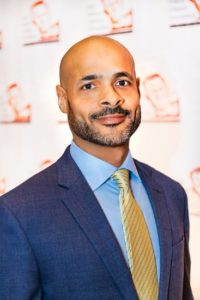 It is hard to ignore the obvious, there are only a few teams who employ a minority coach to either be their offensive coordinator or quarterbacks coach.[225] In the past, the Rooney Rule has led to establishing organizations which promote the growth of minority coaches, whether it be through specific programs or development by the League as a whole to teach and instruct promising minority candidates to grow as coaches.[226] In recent years, there has been a digression in these tactics by the NFL.[227] In past years, the NFL has seen a relatively decent amount of minority head coaches in the NFL.[228] But this has been due to the previous overall outlook of the League, and with that a defensive approach to football games.[229] Today, this has all changed. A solution to combat this is the implementation of programs which increase knowledge among qualified candidates in the offensive approach to football games.[230]
It is hard to ignore the obvious, there are only a few teams who employ a minority coach to either be their offensive coordinator or quarterbacks coach.[225] In the past, the Rooney Rule has led to establishing organizations which promote the growth of minority coaches, whether it be through specific programs or development by the League as a whole to teach and instruct promising minority candidates to grow as coaches.[226] In recent years, there has been a digression in these tactics by the NFL.[227] In past years, the NFL has seen a relatively decent amount of minority head coaches in the NFL.[228] But this has been due to the previous overall outlook of the League, and with that a defensive approach to football games.[229] Today, this has all changed. A solution to combat this is the implementation of programs which increase knowledge among qualified candidates in the offensive approach to football games.[230]
We have to promote initiatives that get more people of color involved on the offensive side of the ball as coaches. Once that happens, and the pipeline builds, I think we’ll start to see the number of coaches of color rise and stabilize.[231]
If the NFL was to put effort into growth of young minority coaches, they will likely see the benefits earlier, and therefore become more qualified to lead a NFL franchise as a head coach.[232] There are too many teams which do not have a minority coach in the room with quarterbacks and this has to be priority number one for the NFL if they want to see the Rooney Rule continue to be an incremental tool for the hiring and progression of minority head coaches in the NFL.[233]
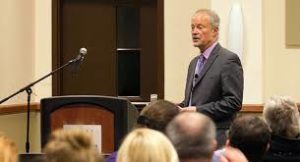 There are a few others who believe that the NFL head coaching patterns are just cycles, and that in a few years, the number of minority coaches will be at a significantly higher level than the current number in charge of NFL franchises.[234] Richard Lapchick, director of the Institute for Diversity and Ethics in Sport at Central Florida, in particular has mentioned “I liked it better when there was eight and not just two [minority coaches], but I do think there is cyclical nature to this and that may be a part of it.”[235] There are examples of this in the past, in particular, Lapchick mentions a similar dip in the hiring of minority coaches after the 2011 through the 2014 season.[236] Then, the hiring picked up again to the point in the last two years when there were eight coaches of color – including Panthers Coach Ron Rivera, who is Hispanic.[237]
There are a few others who believe that the NFL head coaching patterns are just cycles, and that in a few years, the number of minority coaches will be at a significantly higher level than the current number in charge of NFL franchises.[234] Richard Lapchick, director of the Institute for Diversity and Ethics in Sport at Central Florida, in particular has mentioned “I liked it better when there was eight and not just two [minority coaches], but I do think there is cyclical nature to this and that may be a part of it.”[235] There are examples of this in the past, in particular, Lapchick mentions a similar dip in the hiring of minority coaches after the 2011 through the 2014 season.[236] Then, the hiring picked up again to the point in the last two years when there were eight coaches of color – including Panthers Coach Ron Rivera, who is Hispanic.[237]
While evidence from the past may potentially suggest that hiring cycles of minority coaches under the Rooney Rule is cyclical, the most obvious and underlying issue that the NFL faces when dealing with the Rooney Rule and its success is the lack of diversity at the ownership level.[238] “The heart of the issue is far more simple, and yet all the more damning: NFL team owners and GMs only hire who they feel most comfortable with, and oftentimes, that level of ease is less about intellect and ability, and more about cultural similarities.”[239]
With only two minority owners in the NFL and one General Manager who is a minority, the head of organizations have gotten complacent and comfortable in their positions and do not want to have to assimilate to a potentially new culture.[240] They may be willing to select a candidate who is underqualified for a head coaching position because it fits their bill and is relatable to high level executives in the organization.[241] Currently, there are only two offensive coordinators in the NFL who are African American, Eric Bieniemy and Byron Leftwich.[242] A similar ill – that permeates society – racism, prejudice, disproportionate opportunities for whites vs. people of color – are reflected in business. And the NFL is big business.[243] The minority coaches that have underperformed consistently deserved to be fired, and there is no doubt after this season that the majority of the minority coaches that were fired on 2019’s Black Monday were underperforming coaches by today’s standards.[244] “But there is something inherently broken in a system where Wilks is hired and fired within a calendar year and replaced by a college coach who leapfrogged over dozens of worthy candidates because of his reputation as a quarterback whisperer.”[245]
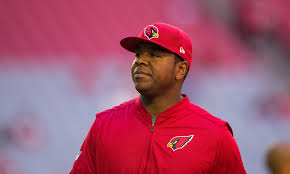 “The criteria NFL franchises use to select their head coaches is completely arbitrary. It’s not about who can do the job. It’s about who front-office executives want to do the job, and worse, the exceptions they’ll make for those coveted candidates.”[246] The League doesn’t look at year to year improvement, but it is putting emphasis on expanding its pipeline of minority coaches, specifically at the offensive coordinator and quarterback coaches’ positions.[247]
“The criteria NFL franchises use to select their head coaches is completely arbitrary. It’s not about who can do the job. It’s about who front-office executives want to do the job, and worse, the exceptions they’ll make for those coveted candidates.”[246] The League doesn’t look at year to year improvement, but it is putting emphasis on expanding its pipeline of minority coaches, specifically at the offensive coordinator and quarterback coaches’ positions.[247]
In the end, there are multiple microcosms of the Rooney Rule which effect the opportunities minority coaches get to become NFL head coaches.[248] The Rooney Rule as currently constructed, does not give minority coaches a real opportunity to strong candidates, and owners and General Managers are content with hiring their cookie cutter type coaches who may not be the best and more experienced coach on the market because they envision the potential of a great offense and a good relationship without having to alter their own thought processes to adapt to a new, minority coach.[249] The NFL needs to update their rule even further, and add more serious punishments to NFL teams who do not comply with the Rooney Rule, along with a program which can develop minority coaches on the offensive side of the ball.
VIII. Conclusion
With the most recent changes to the Rooney Rule made following the hiring of Oakland Raiders Head Coach John Gruden in 2018, there seems to be a growing sense of positivity with regards to the future of minority coaches having an opportunity to be considered for head coaching positions in the NFL. Although the 2019 Black Monday firings were a step back for minority coaches and the representation they currently have in the League, the Rooney Rule as currently constructed will not allow for minority candidates to get a fair shot to be heard by teams in the NFL.
At the end of the day, NFL head coaches have one job and that is to win. If they are able to win games and send their team to the playoffs, they will have a longer tenure in the NFL, just as Marvin Lewis was able to do before his firing this past year. If teams struggle under a coach, no matter what race, they will be forced out of their position, and be replaced with a candidate who embodies what the Owner, General Manager, and others want for their team going forward. With the new Rooney Rule regulations, and the League’s insistence on more aggressive discipline against those who are deemed to violate the Rooney Rule, there may not be growth, despite the thought the hiring of minority coaches is cyclical. The NFL needs to rewrite the rule to allow for minority candidates to get a fair shot at competing for head coaching vacancies, whether it be the development of minority offensive coaches, or stronger punishments for teams that blatantly jump over the “hurdle” they seem to believe is the Rooney Rule.
Jacob Peters is a third-year law student at Marquette University Law School. Along with being a 2020 Juris Doctorate Candidate, Jacob is also a 2020 Marquette Sports Law Certificate candidate earned through the National Sports Law Institute at Marquette University. Jacob is a member of the 2018-19 Sports Law Review at Marquette. Prior to Marquette, Jacob earned his Bachelor of Arts in Political Science with a minor in Management and Leadership from Miami University (OH).
Thank you to my paralegal, Danelle Welzig, for her revisions and editing.
[1] Adam Stites, NFL’s Rooney Rule: What is it and how does it work?, SBNation (2018), https://www.sbnation.com/2018/1/6/16856550/rooney-Rule-nfl-explained-how-it-works-coaches.
[2] Id.
[3] Id.
[4] Id.
[5] Id.
[6] Ryan Sharp, Recent Coaching moves lead to questions about Rooney Rule’s effectiveness, GlobalSport Matters (2019), https://globalsportmatters.com/business/2019/01/28/coaching-moves-questions-rooney-Rules-effectiveness/.
[7] Id.
[8] Luke Knox, NFL Hires in the Rooney Rule Era, The Undefeated (2018), https://theundefeated.com/features/nfl-hires-in-the-rooney-Rule-era/.
[9] Id.
[10] Id.
[11] Id.
[12] Id.
[13] Id.
[14] Id.
[15] David Allen, NFL Head Coaches Fired and Hired After the 2018-19 Season: Photos, Patch (2019), https://patch.com/us/across-america/nfl-head-coaches-fired-hired-after-2018-19-season-photos.
[16] Id.
[17] Id.
[18] Id.
[19] Id.
[20] Id.
[21] Id.
[22] Id.
[23] Id.
[24] David Allen, NFL Head Coaches Fired and Hired After the 2018-19 Season: Photos, Patch (2019), https://patch.com/us/across-america/nfl-head-coaches-fired-hired-after-2018-19-season-photos.
[25] Id.
[26] Luke Knox, NFL Hires in the Rooney Rule Era, The Undefeated (2018), https://theundefeated.com/features/nfl-hires-in-the-rooney-Rule-era/.
[27] Nick Manchester, How Marvin Lewis lasted 16 years, and why he finally got fired, SB Nation Cincy Jungle (2019), https://www.cincyjungle.com/2019/1/13/18172105/bengals-marvin-lewis-16-years-fired-cincinnati-football-seasons-nfl-news.
[28] Id.
[29] Id.
[30] Id.
[31] Id.
[32] Anthony Cosenza, Top 10 Bengals in the Marvin Lewis era: No. 8, Andy Dalton, SB Nation (2018), https://www.cincyjungle.com/2018/7/16/17531262/top-10-bengals-marvin-lewis-era-no-8-andy-dalton.
[33] Id.
[34] Id.
[35] David Allen, NFL Head Coaches Fired and Hired After the 2018-19 Season: Photos, Patch (2019), https://patch.com/us/across-america/nfl-head-coaches-fired-hired-after-2018-19-season-photos.
[36] Marvin Lewis, Pro Football Reference (2019), https://www.pro-football-reference.com/coaches/LewiMa0.htm.
[37] Id.
[38] Fletcher Page, Cincinnati Bengals report: A.J. Green to undergo season-ending surgery, Cincinnati.com (2018), https://www.cincinnati.com/story/sports/nfl/bengals/2018/12/03/aj-green-cincinnati-bengals-injury-season-ending-surgery/2194335002/.
[39] Id.
[40] Id.
[41] Luke Knox, NFL Hires in the Rooney Rule Era, The Undefeated (2018), https://theundefeated.com/features/nfl-hires-in-the-rooney-Rule-era/.
[42] David Allen, NFL Head Coaches Fired and Hired After the 2018-19 Season: Photos, Patch (2019), https://patch.com/us/across-america/nfl-head-coaches-fired-hired-after-2018-19-season-photos.
[43] Id.
[44] Id.
[45] Id.
[46] Id.
[47] John Duffley, Browns Completely Implode, fire both Hue Jackson and Todd Haley, Fan Buzz (2018), https://fanbuzz.com/nfl/browns-fire-hue-jackson/.
[48] Scott Polacek, Tyrod Taylor Named Browns Starting QB over Baker Mayfield During ‘Hard Knocks’, Bleacher Report (2018), https://bleacherreport.com/articles/2791291-tyrod-taylor-named-browns-starting-qb-over-baker-mayfield-during-hard-knocks.
[49] John Duffley, Browns Completely Implode, fire both Hue Jackson and Todd Haley, Fan Buzz (2018), https://fanbuzz.com/nfl/browns-fire-hue-jackson/.
[50] Id.
[51] Id.
[52] Bud Shaw, Gregg Williams never had much traction as the Browns’ long-term answer, WKYC (2019), https://www.wkyc.com/article/sports/commentary/bud-shaw/gregg-williams-never-had-much-traction-as-the-browns-long-term-answer-bud-shaws-sports-spin/95-994c3b43-aca2-426e-84d6-f87f88465642.
[53] Id.
[54] Id.
[55] David Allen, NFL Head Coaches Fired and Hired After the 2018-19 Season: Photos, Patch (2019), https://patch.com/us/across-america/nfl-head-coaches-fired-hired-after-2018-19-season-photos.
[56] Nicki Jhabvala, Why Gary Kubiak decided to reitre from coaching after 23 years, The Denver Post (2017), https://www.denverpost.com/2017/01/02/gary-kubiak-resigns-denver-broncos-head-coach/.
[57] Id.
[58] David Allen, NFL Head Coaches Fired and Hired After the 2018-19 Season: Photos, Patch (2019), https://patch.com/us/across-america/nfl-head-coaches-fired-hired-after-2018-19-season-photos.
[59] Id.
[60] Luke Knox, NFL Hires in the Rooney Rule Era, The Undefeated (2018), https://theundefeated.com/features/nfl-hires-in-the-rooney-Rule-era/.
[61] Tim Lynch, Denver Broncos have fired Vance Joseph, SB Nation Mile High Report (2018), https://www.milehighreport.com/2018/12/31/18134721/vance-joseph-fired-broncos.
[62] Id.
[63] Id.
[64] Mark Kiszla, Why John Elway gave up on Case Keenum and gave the Broncos’ QB job to Joe Flacco, The Denver Post (2019), https://www.denverpost.com/2019/02/28/john-elway-gave-up-on-case-keenum/.
[65] Id.
[66] Id.
[67] Id.
[68] David Allen, NFL Head Coaches Fired and Hired After the 2018-19 Season: Photos, Patch (2019), https://patch.com/us/across-america/nfl-head-coaches-fired-hired-after-2018-19-season-photos.
[69] Id.
[70] Luke Knox, NFL Hires in the Rooney Rule Era, The Undefeated (2018), https://theundefeated.com/features/nfl-hires-in-the-rooney-Rule-era/.
[71] The Associated Press, New York Jets fire Todd Bowles after 4 seasons, Syracuse.com (2018), https://www.syracuse.com/sports/2018/12/new-york-jets-fire-todd-bowles-after-4-seasons.html.
[72] Id.
[73] Id.
[74] Id.
[75] Id.
[76] Id.
[77] Id.
[78] Id.
[79] Id.
[80] Id.
[81] Id.
[82] Id.
[83] Josh Weinfuss, Cardinals fire coach Steve Wilks after one season, ESPN (2018), http://www.espn.com/nfl/story/_/id/25653380/cardinals-fire-coach-steve-wilks-one-season.
[84] David Allen, NFL Head Coaches Fired and Hired After the 2018-19 Season: Photos, Patch (2019), https://patch.com/us/across-america/nfl-head-coaches-fired-hired-after-2018-19-season-photos.
[85] Luke Knox, NFL Hires in the Rooney Rule Era, The Undefeated (2018), https://theundefeated.com/features/nfl-hires-in-the-rooney-Rule-era/.
[86] Josh Weinfuss, Cardinals fire coach Steve Wilks after one season, ESPN (2018), http://www.espn.com/nfl/story/_/id/25653380/cardinals-fire-coach-steve-wilks-one-season.
[87] Id.
[88] Id.
[89] Id.
[90] Id.
[91] Id.
[92] Id.
[93] Id.
[94] Id.
[95] Id.
[96] Id.
[97] Id.
[98] Id.
[99] Josh Weinfuss, The case for and against firing Cardinals coach Steve Wilks, ESPN (2018), http://www.espn.com/blog/arizona-cardinals/post/_/id/31219/the-case-for-and-against-firing-cardinals-coach-steve-wilks
[100] Id.
[101] Id.
[102] NFL coach carousel: Who’s hired, what’s next, ESPN (2019), https://www.espn.com/nfl/story/_/id/25120146/nfl-head-coaching-carousel-2018-2019-everything-know-potential-openings-firings.
[103] Id.
[104] Id.
[105] James Brady, The pros and cons of the Bengals making Zac Taylor their new head coach, SB Nation (2019), https://www.sbnation.com/nfl/2019/1/10/18177676/zac-taylor-bengals-head-coach-rams-cincinnati-report-rumors.
[106] Id.
[107] Id.
[108] Id.
[109] Id.
[110] Michael Schottey, Breaking Down the Relationship Between NFL QBs and Head Coaches, Bleacher Report (2013), https://bleacherreport.com/articles/1878171-breaking-down-the-relationship-between-nfl-qbs-and-head-coaches.
[111] Id.
[112] James Brady, The pros and cons of the Bengals making Zac Taylor their new head coach, SB Nation (2019), https://www.sbnation.com/nfl/2019/1/10/18177676/zac-taylor-bengals-head-coach-rams-cincinnati-report-rumors.
[113] Id.
[114] Id.
[115] James Brady, The pros and cons of the Bengals making Zac Taylor their new head coach, SB Nation (2019), https://www.sbnation.com/nfl/2019/1/10/18177676/zac-taylor-bengals-head-coach-rams-cincinnati-report-rumors.
[116] Id.
[117] Id.
[118] Id.
[119] Doug Farrar, Browns hire Freddie Kitchens: Instant analysis of Cleveland’s new head coach, Touchdown Wire (2019), https://touchdownwire.usatoday.com/2019/01/09/browns-hire-freddie-kitchens-instant-analysis-of-clevelands-new-head-coach/.
[120] Id.
[121] Id.
[122] Christian D’Andrea, The Browns hire Freddie Kitchens, the guy who brought Baker Mayfield back to life, as head coach, SB Nation (2019), https://www.sbnation.com/2019/1/9/18175307/browns-head-coach-freddie-kitchens-baker-mayfield.
[123] Id.
[124] Id.
[125] Id.
[126] Jeff Legwold, Broncos reach agreement with Vic Fangio to be head coach, ESPN (2019), http://www.espn.com/nfl/story/_/id/25721280/denver-broncos-hiring-vic-fangio-coach.
[127] Id.
[128] Id.
[129] Id.
[130] Id.
[131] Sean Wanger-McGough, Grading the eight NFL head coach hires: Bruce Arians, Vic Fangio, Freddie Kitchens receive highest marks, CBS Sports (2019), https://www.cbssports.com/nfl/news/grading-the-eight-nfl-head-coach-hires-bruce-arians-vic-fangio-freddie-kitchens-receive-highest-marks/.
[132] Id.
[133] Id.
[134] Id.
[135] Id.
[136] Id.
[137] Id.
[138] Kevin Zimmerman, The 5: Resume highlights for Kilff Kingsbury as Cardinals head coach, Arizona Sports (2019), http://arizonasports.com/story/1795615/resume-highlights-kliff-kingsbury-cardinals-head-coach/.
[139] Id.
[140] Id.
[141] Id.
[142] Id.
[143] Id.
[144] Id.
[145] Id.
[146] Id.
[147] Josh Weinfuss, Cardinals fire coach Steve Wilks after one season, ESPN (2018), http://www.espn.com/nfl/story/_/id/25653380/cardinals-fire-coach-steve-wilks-one-season.
[148] Kevin Zimmerman, The 5: Resume highlights for Kilff Kingsbury as Cardinals head coach, Arizona Sports (2019), http://arizonasports.com/story/1795615/resume-highlights-kliff-kingsbury-cardinals-head-coach/.
[149] Id.
[150] Sean Wagner-McCough, Dolphins hire Brian Flores as new coach after defensive master-class in Super Bowl, CBS Sports (2019), https://www.cbssports.com/nfl/news/dolphins-hire-brian-flores-as-new-coach-after-patriots-defensive-master-class-in-super-bowl/.
[151] Id.
[152] Id.
[153] Id.
[154] Id.
[155] Id.
[156] Id.
[157] Mike Jones, NFL: Raiders complied with ‘Rooney Rule’ when hiring Jon Gruden, USA Today (2018), https://www.usatoday.com/story/sports/nfl/2018/01/19/nfl-raiders-complied-with-rooney-Rule-when-hiring-gruden/109609240/.
[158] Id.
[159] Id.
[160] Id.
[161] Id.
[162] Id.
[163] Id.
[164] Id.
[165] Jason Reid, It’s time for the NFL to take the Rooney Rule seriously or get rid of it, The Undefeated (2018), https://theundefeated.com/features/its-time-for-the-nfl-to-take-the-rooney-rule-seriously-or-get-rid-of-it/.
[166] Id.
[167] Id.
[168] Id.
[169] Id.
[170] Id.
[171] National Football League, NFL expands Rooney Rule requirements to strengthen diversity, National Football League News (2018), http://www.nfl.com/news/story/0ap3000000999110/article/nfl-expands-rooney-Rule-requirements-to-strengthen-diversity.
[172] Id.
[173] National Football League, NFL expands Rooney Rule requirements to strengthen diversity, National Football League News (2018), http://www.nfl.com/news/story/0ap3000000999110/article/nfl-expands-rooney-Rule-requirements-to-strengthen-diversity.
[174] Jarrett Bell, Jon Gruden Rule? NFL makes changes to Rooney Rule in light of Raiders’ process, USA Today (2018), https://www.usatoday.com/story/sports/nfl/2018/12/12/nfl-rooney-rule-minority-coaches-oakland-raiders-jon-gruden/2291764002/.
[175] Id.
[176] Al Neal, African-American head coaches fired after changes to Rooney Rule, People’s World (2019), https://www.peoplesworld.org/article/african-american-head-couches-fired-after-changes-to-rooney-Rule/.
[177] Id.
[178] Id.
[179] Id.
[180] Fritz Pollard Alliance Has No Issue With NFL’s Black Monday Firings, Sports Business Daily (2019), https://www.sportsbusinessdaily.com/Daily/Issues/2019/01/02/Leagues-and-Governing-Bodies/Black-Coaches.aspx
[181] Mark Maske, This NFL firing cycle is disproportionately affecting minority head coaches, The Washington Post (2018), https://www.washingtonpost.com/sports/2018/12/31/this-nfl-firing-cycle-is-disproportionately-affecting-minority-head-coaches/?utm_term=.04edb8d9ab5a.
[182] Lauren Victoria Burke, Five African American NFL Head Coaches Fired, The San Diego Voice & Viewpoint (2019), https://sdvoice.info/five-african-american-nfl-head-coaches-fired/.
[183] Jason Reid, NFL creates list to strengthen Rooney Rule, ESPN (2018), http://www.espn.com/nfl/story/_/id/25518202/nfl-creates-list-strengthen-rooney-rule.
[184] Id.
[185] Id.
[186] Mark Maske, NFL toughens its Rooney Rule standards for interviewing head coaching candidates, The Washington Post (2018), https://www.washingtonpost.com/sports/2018/12/12/nfl-toughens-its-rooney-rule-standards-interviewing-head-coaching-candidates/?utm_term=.2817951b177e.
[187] Id.
[188] Id.
[189] Mark Maske, Lions’ Millen is Fined $200,000, The Washington Post (2003), https://www.washingtonpost.com/archive/sports/2003/07/26/lions-millen-is-fined-200000/28c20bfc-b3c4-4cf1-8d1e-28c29147dd8b/?utm_term=.d6184b6bbe70.
[190] Jason Reid, Future of black NFL coaches a concern after round of firings, The Undefeated (2018), https://theundefeated.com/features/future-of-black-nfl-coaches-a-concern-after-round-of-firings/.
[191] Dan Cancian, Broadcaster claims black coaches in the NFL are victims of white privilege, Newsweek (2019), https://www.newsweek.com/nfl-black-coaches-dale-hansen-black-monday-nfl-white-privilege-rooney-rule-1286289.
[192] Id.
[193] Id.
[194] Id.
[195] Carol Ozemhoya, Several Black NFL coaches fired – League under scrutiny, Our Weekly (2019), http://ourweekly.com/news/2019/jan/02/several-black-nfl-coaches-fired-league-under-scrut/.
[196] Max Staley, Offensive Head Coaches Dominate the NFL Playoff Picture This Season, Fanduel (2019), https://www.fanduel.com/theduel/posts/6268171-offensive-head-coaches-dominate-the-nfl-playoff-picture-this-season.
[197] Luke Knox, NFL Hires in the Rooney Rule Era, The Undefeated (2018), https://theundefeated.com/features/nfl-hires-in-the-rooney-Rule-era/.
[198] Id.
[199] Id.
[200] Id.
[201] Id.
[202] Kimberley A. Martin, A Google search summaries the NFL’s struggles with hiring minority head coaches, Yahoo Sports (2019), https://sports.yahoo.com/google-search-summarizes-nfls-struggles-hiring-minority-head-coaches-001910299.html.
[203] Id.
[204] Id.
[205] IU economist’s study: NFL Rooney Rule hasn’t led to hiring or minority coaches, IU News Room (2013), http://newsinfo.iu.edu/web/page/normal/17626.html.
[206] Id.
[207] Id.
[208] Id.
[209] Dave Zirin, The NFL Has Fired Almost All of Its Black Coaches, The Nation (2019), https://www.thenation.com/article/black-monday-nfl/.
[210] Id.
[211] Id.
[212] Fritz Pollard Alliance Has No issue With NFL’s Black Monday Firings, Sports Business Journal Daily (2019), https://www.sportsbusinessdaily.com/Daily/Issues/2019/01/02/Leagues-and-Governing-Bodies/Black-Coaches.aspx.
[213] Id.
[214] Victor Mather, A Timeline of Colin Kaepernick vs. the N.F.L., The New York Times (2019), https://www.nytimes.com/2019/02/15/sports/nfl-colin-kaepernick-protests-timeline.html.
[215] Bill Pennington and Ken Belson, Firing of Several Black Coaches Puts N.F.L. Hiring Under Scrutiny, The New York Times (2018), https://www.nytimes.com/2018/12/31/sports/nfl-black-coaches-fired.html.
[216] Id.
[217] Id.
[218] Id.
[219] Max Staley, Offensive Head Coaches Dominate the NFL Playoff Picture This Season, Fanduel (2019), https://www.fanduel.com/theduel/posts/6268171-offensive-head-coaches-dominate-the-nfl-playoff-picture-this-season.
[220] Id.
[221] Jason Reid, The NFL’s racial divide, The Undefeated (2017), https://theundefeated.com/features/the-nfls-racial-divide/.
[222] Max Staley, Offensive Head Coaches Dominate the NFL Playoff Picture This Season, Fanduel (2019), https://www.fanduel.com/theduel/posts/6268171-offensive-head-coaches-dominate-the-nfl-playoff-picture-this-season.
[223] Id.
[224] Dave Zirin, The NFL Has Fired Almost All of Its Black Coaches, The Nation (2019), https://www.thenation.com/article/black-monday-nfl/.
[225] Barry Wilner, AP analysis: Few minority NFL coaches in top offensive jobs, USA Today (2019), https://www.usatoday.com/story/sports/nfl/2019/01/30/nfls-scoring-boom-contributes-to-drop-in-minority-coaches/38976537/.
[226] Heylee Bernstein, The Rooney and Mansfield Rules: Diversity Programs in Structurally Different Industries, On Labor (2019), https://onlabor.org/the-rooney-and-mansfield-rules-diversity-programs-in-structurally-different-industries/.
[227] Id.
[228] Id.
[229] Leigh Steinberg, Offense, Not Defense, Wins Championships In Modern NFL, Forbes (2019), https://www.forbes.com/sites/leighsteinberg/2019/01/18/offense-not-defense-wins-championships-in-modern-nfl/#26d965566ade.
[230] Dave Zirin, The NFL Has Fired Almost All of Its Black Coaches, The Nation (2019), https://www.thenation.com/article/black-monday-nfl/.
[231] Id.
[232] Id.
[233] Id.
[234] Tim Dahlberg, Column: Where have all the NFL’s black coaches gone?, Associated Press (2019), https://www.apnews.com/4c9519b410b44a70beb2250b21a2f4b2.
[235] Id.
[236] Id.
[237] Id.
[238] Kimberley A. Martin, A Google search summarizes the NFL’s struggles with hiring minority head coaches, Yahoo Sports (2019), https://sports.yahoo.com/google-search-summarizes-nfls-struggles-hiring-minority-head-coaches-001910299.html.
[239] Id.
[240] Ahiza Garcia, These are the only two owners of color in the NFL, CNN Money (2018), https://money.cnn.com/2018/05/18/news/nfl-nba-mlb-owners-diversity/index.html.
[241] Id.
[242] Kimberley A. Martin, A Google search summarizes the NFL’s struggles with hiring minority head coaches, Yahoo Sports (2019), https://sports.yahoo.com/google-search-summarizes-nfls-struggles-hiring-minority-head-coaches-001910299.html.
[243] Id.
[244] Chris Mueller, The biggest controversies of the 2018-19 NFL season, Yardbarker (2019), https://www.yardbarker.com/nfl/articles/the_biggest_controversies_of_the_2018_19_nfl_season/s1__28139009#slide_1.
[245] Kimberley A. Martin, A Google search summarizes the NFL’s struggles with hiring minority head coaches, Yahoo Sports (2019), https://sports.yahoo.com/google-search-summarizes-nfls-struggles-hiring-minority-head-coaches-001910299.html.
[246] Id.
[247] Id.
[248] Ryan Sharp, Recent Coaching moves lead to questions about Rooney Rule’s effectiveness, GlobalSport Matters (2019), https://globalsportmatters.com/business/2019/01/28/coaching-moves-questions-rooney-Rules-effectiveness/.
[249] Id.


